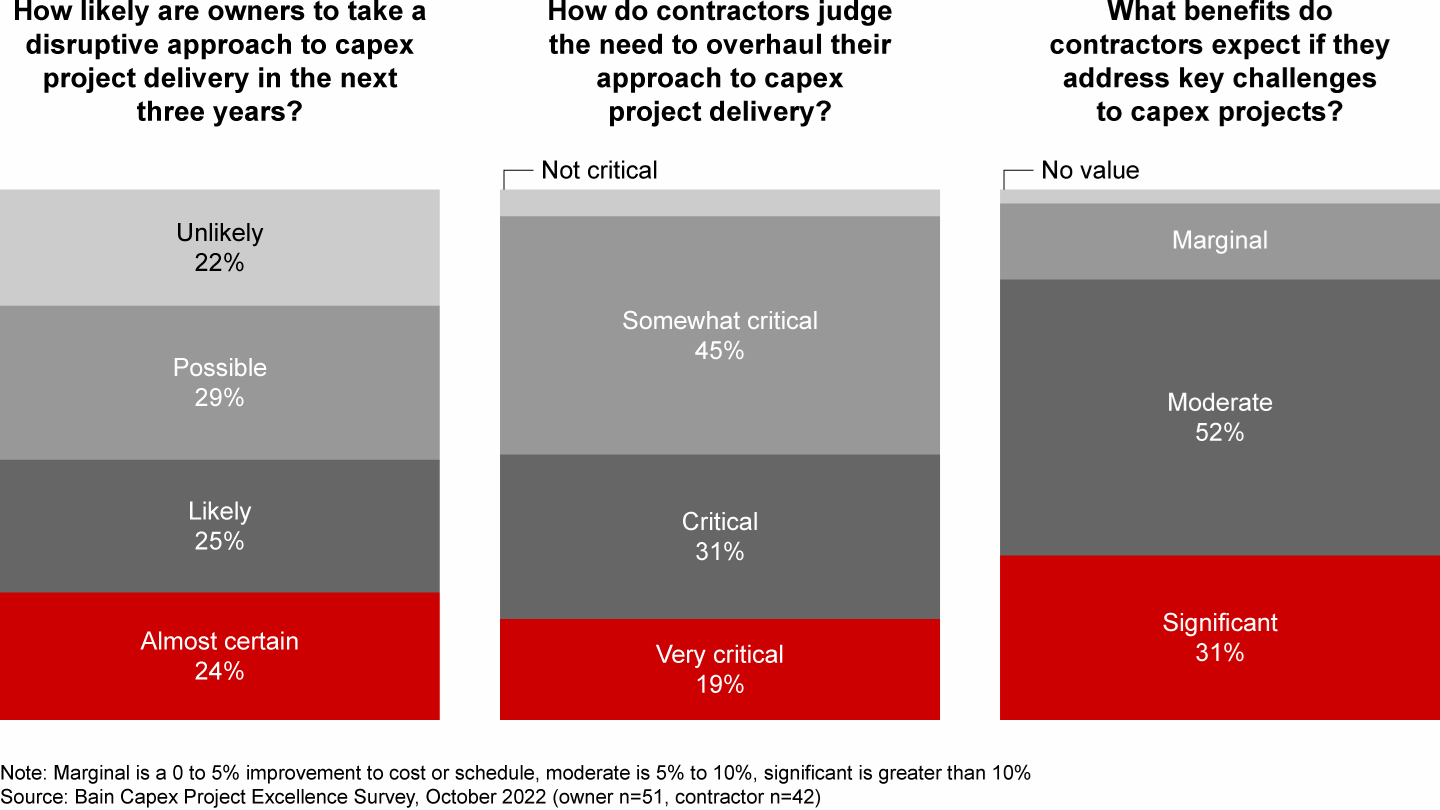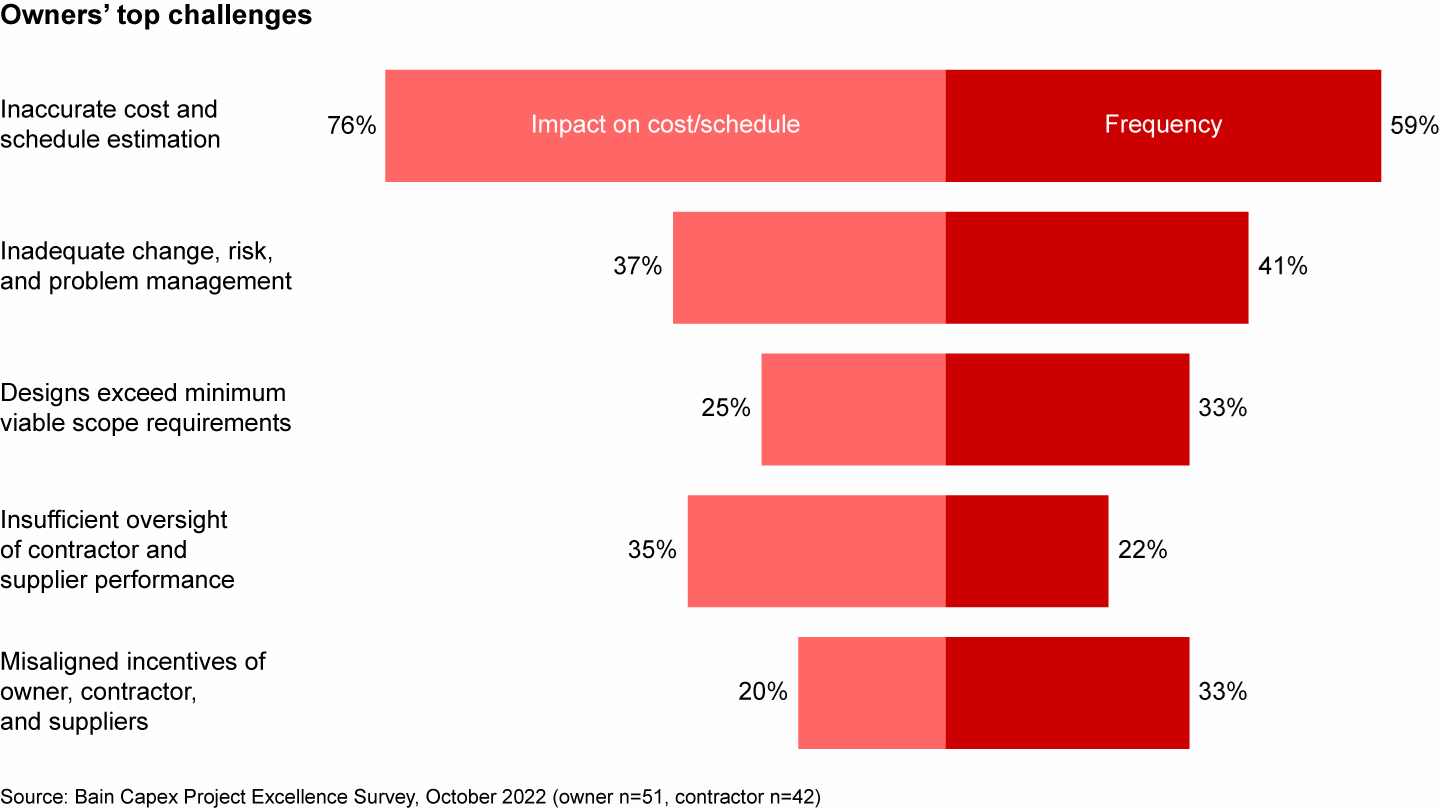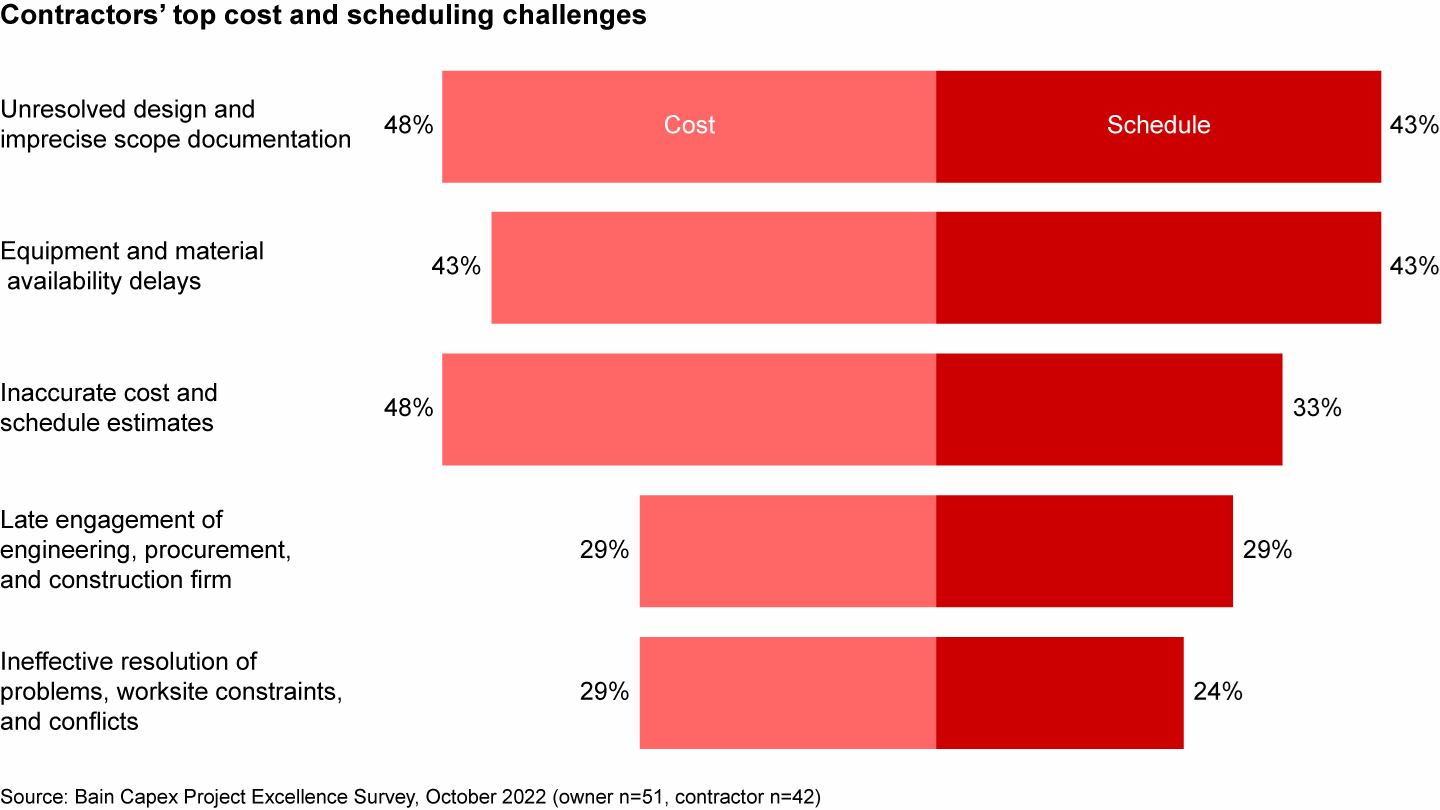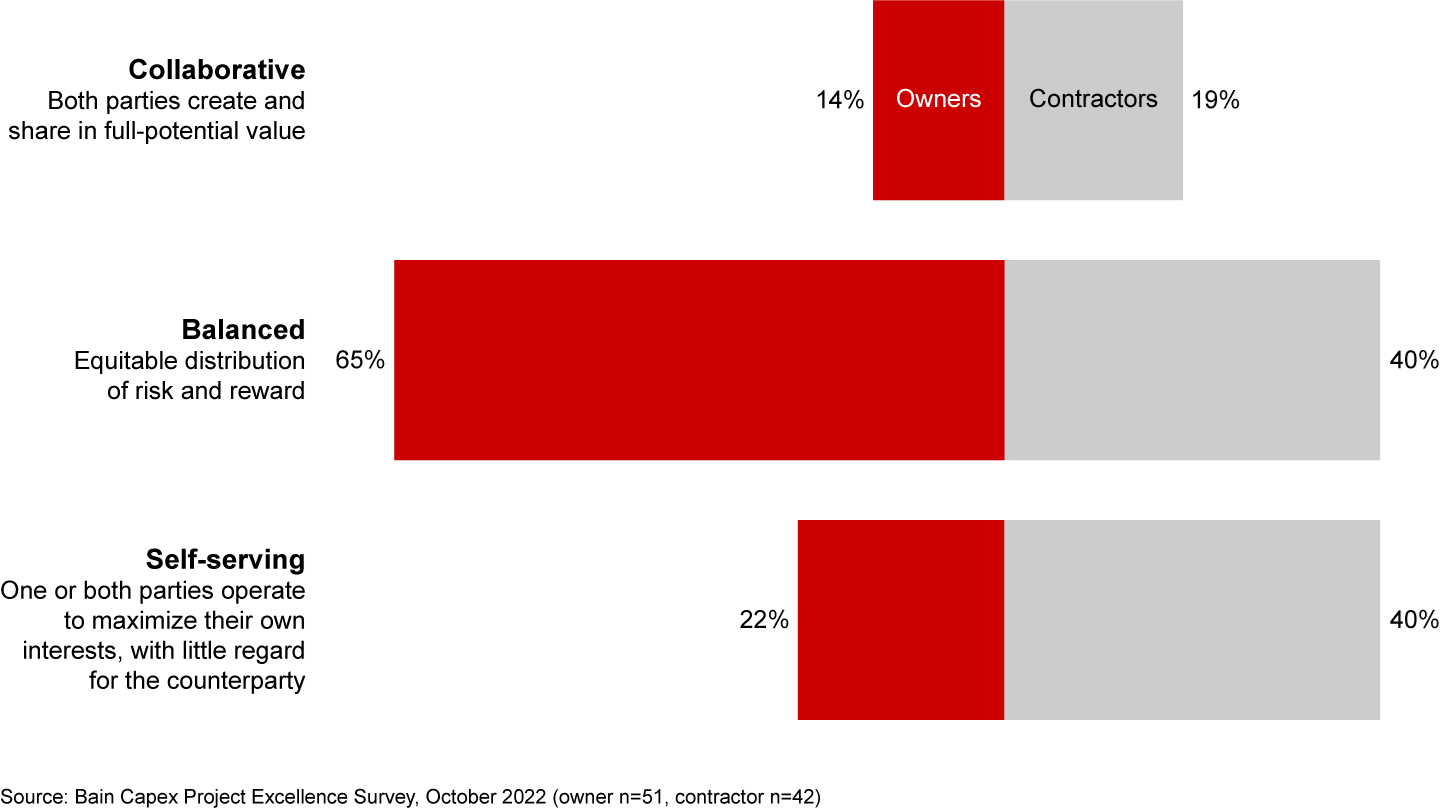Brief

Auf einen Blick
- Annual spending on energy-related capex projects is forecast to grow to $3 trillion to $5 trillion by 2030.
- A majority of contractors in a recent Bain survey see an opportunity to reduce project costs by 5% to 10%.
- Project owners and contractors agree that cost forecasts are often flawed, leaving project teams a narrow window for success.
It’s a recurring plight that confounds many leadership teams. Large capital projects in energy and natural resources typically run over budget and fall behind schedule, sharply eroding returns. From 2015 to 2019, for example, upstream and midstream oil and gas capital projects suffered an average delay of 2.5 years and an average cost overrun of 17%.
While the risk of global recession has put many capital investment decisions on hold, the looming energy transition will unleash an unprecedented wave of spending in the coming decade on renewable energy infrastructure, energy-efficient buildings, and clean transportation. The International Energy Agency forecasts capital spending on the energy transition will grow to $3 trillion to $5 trillion annually by 2030—two to four times current outlays. The exact timing of those investments will depend on project approvals and funding. But the added strain from any surge in spending is likely to overwhelm companies managing capital projects and put projects at risk.
Bain research shows energy and utilities companies (project owners) and engineering, procurement, and construction (EPC) contractors agree on the need to overhaul the management of large-scale capital projects (see Figure 1). Instead of striving to minimize cost, which often backfires on large projects, leading project owners are exploring more collaborative, win-win relationships with contractors. In fact, a majority of contractors see an opportunity to reduce costs by 5% to 10% by addressing the key challenges facing major energy projects.
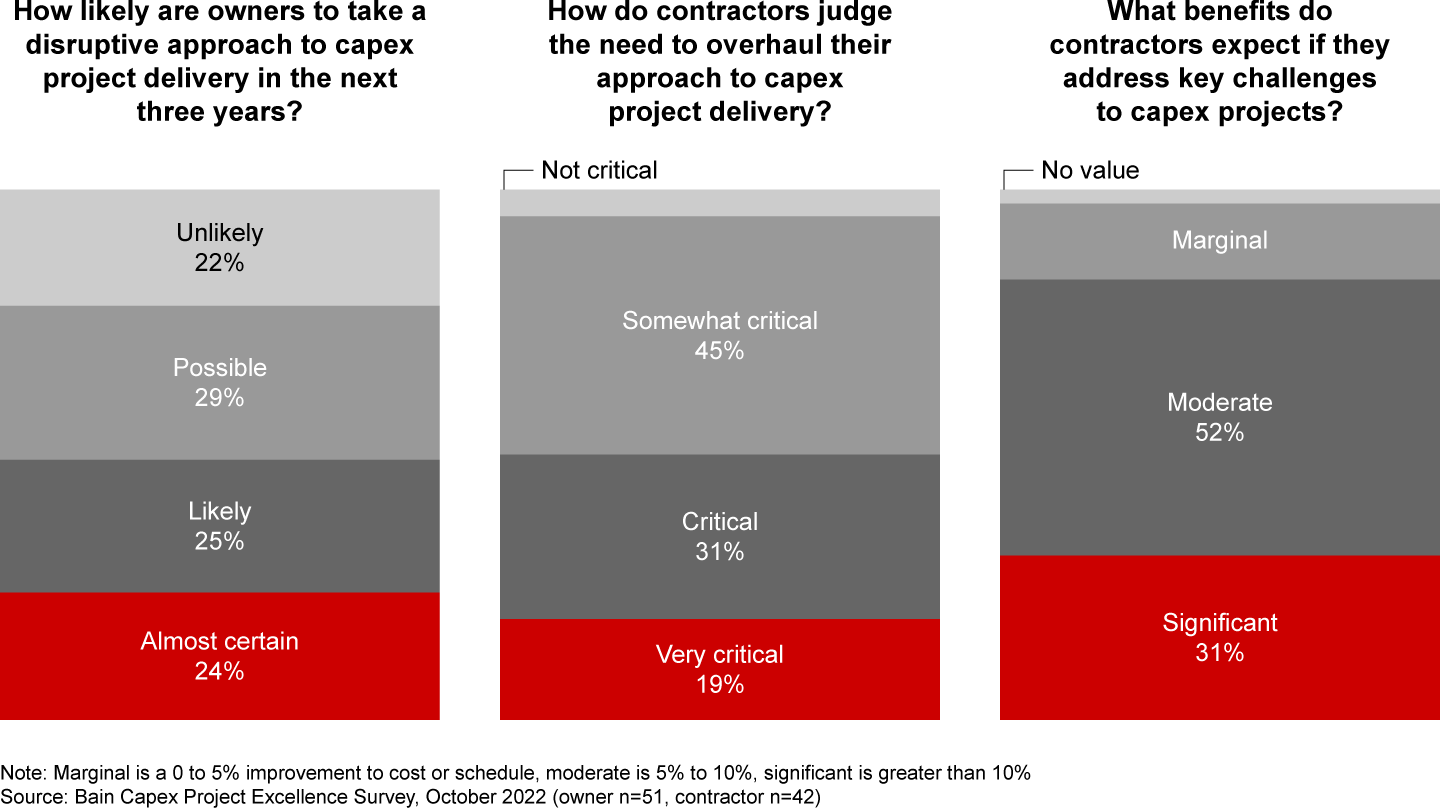
Owners and contractors agree cost estimate forecasts are often flawed. In our experience, such forecasts often are disconnected from critical insights about project costs. Unrealistic planning leaves project teams a narrow window for success, increasing the risk of cost overruns and delays. That, in turn, creates adversarial relationships among teams working in the project ecosystem. For example, many owners map out a project schedule that doesn’t adequately account for site-specific productivity differences and labor constraints, which are common. As a result, contractors are unable to execute the plan as written, and they struggle to adapt to changing conditions (see Figure 2).
The energy transition is likely to increase the size of and variety of capex projects in addition to the volume, adding to the strain. Managing efficiently under those conditions will require a more holistic approach. Forward-looking project owners are starting to examine the entire project-delivery value chain for opportunities to improve performance—from site identification to commissioning of the asset. They’re also seeking to build more collaborative relationships with the many stakeholders and contractors involved in all phases of a project. Some are piloting win-win contracts that overcome the negative spiral that results from a strategy focused too narrowly on cost reduction and performance expectations divorced from reality. Finally, leaders are adding talent and capacity in critical support functions to help secure permits, acquire sites, and improve public and customer communications.
But implementing change will be challenging. Owners and contractors still view a significant percentage of their engagements as self-serving. Contractors are nearly twice as likely to perceive one or both sides as self-serving (see Figure 3). Owners and contractors aren’t aligned on the equitable distribution of risk and reward in projects, and fewer than one in five describe their engagement model as collaborative.
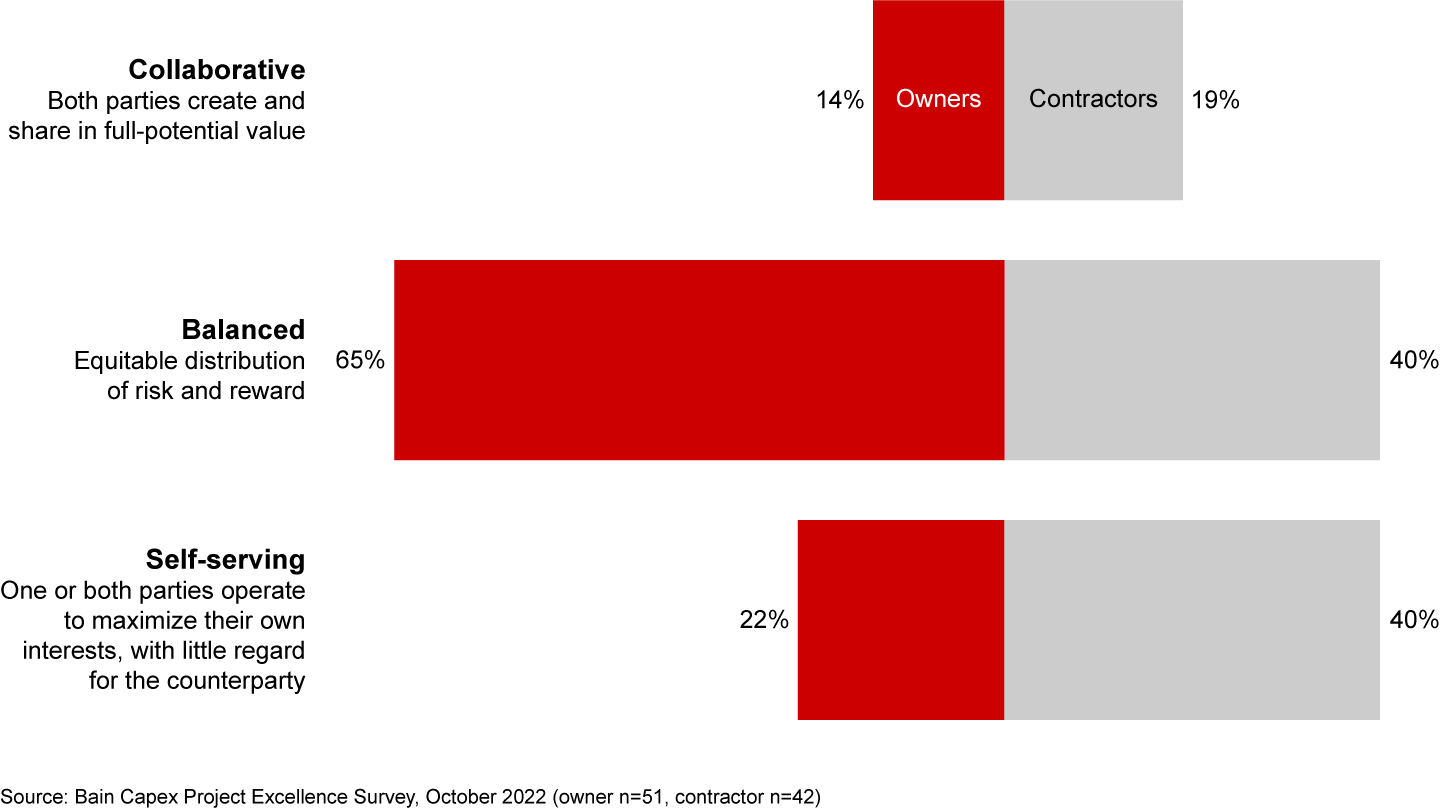
Leading energy and natural resource companies can unlock powerful advantages by developing a more integrated and collaborative approach to capital project management. In addition to reducing costs and improving delivery times, it enhances transparency and predictability, improves schedule accuracy, and creates an environment for optimal returns. Five guidelines can help project teams start down the path to better performance.
Take an agile approach to project management. Tackle challenges early and do scenario planning to address possible failures. That will help project teams quickly identify potential problems while there’s still time to correct course.
Apply a stress test to the value chain. Assess the project’s demand for permits, labor, equipment, and material resources and gauge the market capacity to meet those needs. Identifying potential stress points and shortages early means more time to resolve them. For instance, a top US electric utility conducting a stress test developed a three-year view of procurement in place of a quarterly view. That forward visibility increased the firm’s resilience and put capital to work more effectively.
Reinforce the organization and operating model. Evaluate the firm’s ability to react to a surge in product demand. Strengthen talent, structure, processes, and systems as needed. Develop plans to mitigate problems before they create costly issues and delays.
Embrace nimble execution. Anticipate disruption and make sure your strategy can adapt to change. Take the example of leading companies extracting shale gas and tight oil. They understood from the outset that rigid plans were ill-adapted to such operations and made adaptability a top priority. These companies routinely adjust operations to the volume and pace of activity and to vital input from equipment and service providers. Importantly, they incorporate lessons learned from each drilled well into field-development processes. While capital projects may differ significantly, the flexible approach that shale companies developed to accommodate uncertainty and change can be applied to a wide array of operations.
Improve supplier relationships. Develop a more dynamic and collaborative partnership with key suppliers and contractors and take a more balanced approach to sharing risks. Before bidding, some leading companies are starting to engage EPC companies in collaborative workshops to codevelop commercial pricing structures that are transparent and equitable, and enhance owner and contractor buy-in. One leading US electric utility, eager to move away from conventional lump-sum bidding, set up workshops with EPC contractors to jointly develop long-term, dynamic commercial pricing structures. The workshops increased mutual understanding of common pain points and the success factors required for an efficient commercial structure.
Getting started
For many leadership teams, adopting new approaches to project planning and execution may feel uncomfortable. But as the energy transformation accelerates, it will further strain the ability to deliver projects on time and on budget. The alternative—sticking to current management practice—is riskier. Companies that fail to prepare their organizations for a step-change in demand will find it even more difficult in the future to meet their performance goals.
Here are a few questions senior executives can use to begin to reorient their thinking ahead of the capex spending surge.
- How can we accelerate steps such as obtaining permits and acquiring land to ensure projects start on time?
- Can we minimize disparities in the supply and demand of equipment and materials to avoid delays and cost overruns?
- What actions would help improve the supply of qualified labor, and where do we begin to create development programs to improve workforce skills?
- Are our strategic partners open to adopting new ways of working to resolve the most critical problems plaguing capital project delivery?
- How can we leverage emerging technologies, such as artificial intelligence and the Internet of Things, to enhance our capital project-delivery processes and respond better to unforeseen challenges?
Energy and natural resources companies will shoulder the bulk of the transition to a new energy era as investments in infrastructure accelerate. The number and size of capital projects needed to meet society’s climate goals will overwhelm companies that aren’t prepared to manage them more efficiently. Leadership teams that boldly break with the industry’s narrow focus on cost management and start developing more collaborative relationships with contractors will be in the best position to navigate the challenging transition ahead.


